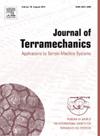Tractive performance analysis of the SRTT with respect to the spin count and the ASTM F1805 parameters
IF 3.7
3区 工程技术
Q3 ENGINEERING, ENVIRONMENTAL
引用次数: 0
Abstract
Snow is a complex material. Its mechanical properties are influenced by various factors such as ambient temperature, solar radiation, compaction, metamorphism, etc., making it complex to model and predict them. To date, only a few studies have focused on predicting the traction coefficient as a function of ambient temperature, snow temperature, and snow compaction (CTI Index). These parameters are measured in accordance with The ASTM F1805 standard, which is used to evaluate the straight-line tractive performance of tires on snow.
This study introduces an additional parameter: spin count and investigates its effect on tractive performance. It was observed for the 16-inch SRTT that the traction coefficient of the control tire decreased progressively as the season advanced. The study aims to determine whether a similar trend applies to a 14-inch SRTT and correlates the tractive performance of individual control tires with ASTM F1805 parameters using regression analysis. Furthermore, it seeks to identify the most accurate regression algorithm for predicting the tractive coefficient and ranks the most influential parameters through feature selection.
In summary, this research examines the influence of spin count on tire traction, aiming to improve prediction models and identify key parameters influencing performance on snow.
SRTT在自旋数和ASTM F1805参数方面的牵引性能分析
雪是一种复杂的物质。其力学性能受环境温度、太阳辐射、压实作用、变质作用等多种因素的影响,建模和预测较为复杂。迄今为止,只有少数研究集中于预测牵引系数作为环境温度、雪温和雪压实度(CTI指数)的函数。这些参数是根据ASTM F1805标准测量的,该标准用于评估轮胎在雪地上的直线牵引性能。本研究引入一个额外的参数:自旋数,并探讨其对牵引性能的影响。对于16英寸SRTT,随着季节的推进,对照轮胎的牵引力系数逐渐减小。该研究旨在确定类似的趋势是否适用于14英寸SRTT,并使用回归分析将单个控制轮胎的牵引性能与ASTM F1805参数相关联。此外,它寻求识别最准确的回归算法来预测牵引系数,并通过特征选择对最具影响力的参数进行排序。综上所述,本研究考察了旋转次数对轮胎牵引力的影响,旨在改进预测模型并确定影响雪地性能的关键参数。
本文章由计算机程序翻译,如有差异,请以英文原文为准。
求助全文
约1分钟内获得全文
求助全文
来源期刊

Journal of Terramechanics
工程技术-工程:环境
CiteScore
5.90
自引率
8.30%
发文量
33
审稿时长
15.3 weeks
期刊介绍:
The Journal of Terramechanics is primarily devoted to scientific articles concerned with research, design, and equipment utilization in the field of terramechanics.
The Journal of Terramechanics is the leading international journal serving the multidisciplinary global off-road vehicle and soil working machinery industries, and related user community, governmental agencies and universities.
The Journal of Terramechanics provides a forum for those involved in research, development, design, innovation, testing, application and utilization of off-road vehicles and soil working machinery, and their sub-systems and components. The Journal presents a cross-section of technical papers, reviews, comments and discussions, and serves as a medium for recording recent progress in the field.
 求助内容:
求助内容: 应助结果提醒方式:
应助结果提醒方式:


